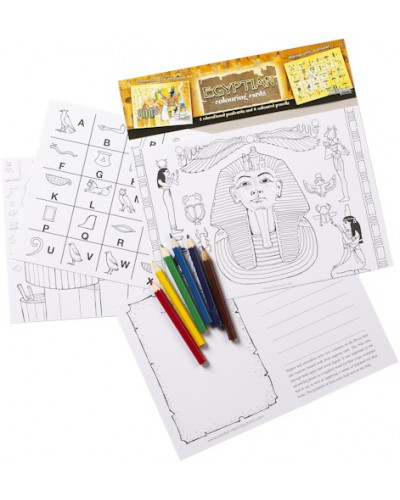Product Description: The Egyptian Colouring Postcards consists of four A5 size colouring cards and six colouring pencils. The cards include a single image of Tutankhamun’s gold mask and other artifacts, a mummification scene, a River Nile scene, and a card depicting the hieroglyphs that make up the alphabet. On the reverse of each card is an area to write a message, an address and to affix a stamp as well as educational information about the images on each card. There is a colourful header card that has pictures showing how the cards could be coloured in and all are held in a clear cellophane bag.
Information: Tutankhamun is the most famous Egyptian pharaoh. The boy king died in his late teens over 3000 years ago and was buried in the Valley of the Kings. A mask of solid gold was placed over the head and shoulders of Tutankhamun’s mummy. The vulture’s head upon the brow, symbolised sovereignty over Upper Egypt. By its side is the cobra, symbolising sovereignty over Lower Egypt.
The ancient Egyptians felt that death in one world was the beginning of life in another world. But in order to enjoy that life, the Egyptians believed that their bodies must be preserved. Before placing the body in a coffin, the last rites were performed by a priest, wearing the mask of the jackal-headed god, Anubis. The ancient Egyptians used canopic jars during the rituals of mummification processes as containers in which to hold the internal organs of the deceased.
Hippos and crocodiles were very common on the River Nile and warriors hunted both from papyrus rafts. The Nile runs through both upper and lower Egypt. It was important to the ancient Egyptians as it supplied water for their crops, sustained fish to eat, as well as supplying a means of transport for their boats. The pyramids at Giza were built next to the Nile.
Hieroglyphics were the language used by the ancient Egyptians. They were written in rows or columns and would be read from left to right or from right to left. You can distinguish the direction in which the text is to be read because the human or animal figures always face towards the beginning of the line. Also, the upper symbols are read before the lower.
Tags: Egyptian, Educational, Colouring, Postcards

